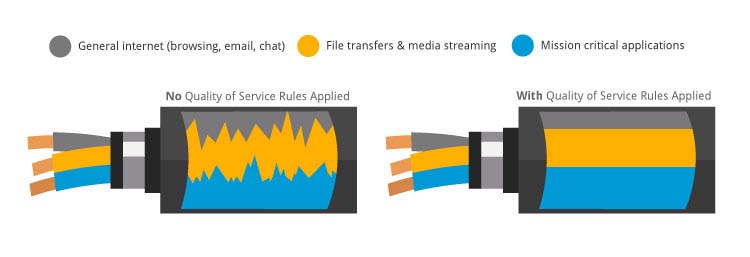Knowing how to prioritize and keep network traffic running smoothly for everyone is an important responsibility as a network administrator.
There are several things you can do to prioritize network traffic:
- Reserve Bandwidth for Business-critical Applications
- Slow Non-essential Traffic
- Manage Latency
- Schedule Network Intensive Processes
Traffic Shaping
Because network bandwidth is limited, it needs to be managed. One of the ways this is done is by traffic shaping, which identifies and classifies network traffic. Sources of network traffic are not of equal value or importance and may have different service level agreements.
Traffic shaping converges network technologies into a common network architecture, which ensures performance requirements for critical applications. Traffic is generally categorized in three levels high, medium and low priority.
High Priority traffic requires guaranteed network performance that is free of lag and latency. This traffic should not be impacted by interference from lower network traffic categories.
Medium Priority traffic should receive good performance with minimal interruption, dropped packets and sessions.
Low Priority traffic is non-critical or not sensitive to network performance. Its low criticality means that this traffic can be pushed behind High and Medium traffic and dropped packets can be queued as bandwidth becomes available.
High Priority traffic is forwarded immediately, and Medium and Low Priority traffic is rate limited using techniques such as bandwidth throttling, congestion control and packet dropping.
Bandwidth throttling reduces network speed to reduce traffic. Congestion control works by identifying congestion or situations that may lead to congestion and reducing the amount of data being transferred. And packet dropping discards packets of data, usually low priority data, to provide more bandwidth to high priority traffic. Or, you can reroute data along alternate paths.
RELATED POST:
Detecting & Solving Network bottlenecks
Quality of Service
One approach to monitoring and creating traffic classes is known as Quality of Service (QoS). In order to measure QoS, different but related parts of network services are taken into consideration, including availability, bit rate, jitter, packet loss, throughput and transmission delay.
In order to use QoS to create traffic classes, you must first understand application requirements as well as business application priorities and network utilization.
Application requirements include batch, burst and jitter requirements, packet size, time-out and performance issues. When these things are understood, traffic shaping plans and configurations can be created that provide consistent application performance.

Manage Latency
Latency is the time it takes for a packet to travel from its origin to its destination and is typically measured in milliseconds (ms). It can impact network performance in a way that’s especially noticeable with todays’ growing list of latency sensitive applications, such as VOIP and video conferencing.
Because of routing and processing delays, latency can become an issue. It’s also impacted by the distance, or wire speed, of the connection. Packet inspection can also cause delays, by firewalls or servers, and all of these delays add up.
Network monitoring tools can be used to track network traffic and many offer tools to measure latency. If latency is an issue, you may want to look into the DNS service your network is using to see if it checks the IP addresses of websites, which can cause delays. Having a dedicated connection can also reduce latency, if that’s practical for your situation.
Scheduling
A scheduler works by managing the network packets being transmitted and uses logic to determine which packet to send next. It temporarily stores packets until they are transmitted.
Depending on network traffic, it may not be possible to send all packets along, which is when the scheduler will decide what traffic to send and what to de-prioritize and drop or send later.
Using a scheduler can keep computer resources busy (such as load balancing) and effectively share system resources across all users. It can also help achieve QoS by maximizing throughput, minimizing wait time, latency and response time.
Exception Management
Another method of controlling network traffic is exception management. When monitoring the network, an alarm may be generated for especially high CPU on a specific router.
The network administrator can log in to the router and find the cause of the high CPU and change the configuration to reduce CPU or create an access-list to prevent the traffic that’s causing the high CPU. However, this should only be done for non-business-critical traffic.
By monitoring and prioritizing your network traffic you should be able to avoid the congestion and latency that impacts user performance. If you have questions about optimizing your network, contact one of our experienced representatives.




